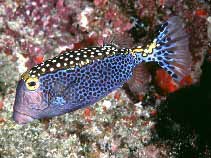
Crabs are decapod crustaceans of the infraorder Brachyura, which typically have a very short projecting "tail" (abdomen), usually hidden entirely under the thorax. They live in all the world's oceans, in fresh water, and on land, are generally covered with a thick exoskeleton, and have a single pair of pincers. They first appeared during the Jurassic Period.

Triggerfish are about 40 species of often brightly colored fish of the family Balistidae. Often marked by lines and spots, they inhabit tropical and subtropical oceans throughout the world, with the greatest species richness in the Indo-Pacific. Most are found in relatively shallow, coastal habitats, especially at coral reefs, but a few, such as the oceanic triggerfish, are pelagic. While several species from this family are popular in the marine aquarium trade, they are often notoriously ill-tempered.

The black sea bass is a species of marine ray-finned fish, a sea bass from the subfamily Serraninae which is part of the family Serranidae, which also includes the groupers and anthias. It is found in the western Atlantic Ocean where it is an important species for commercial and recreational fisheries.

Mycteroperca microlepis, the gag, gag grouper, velvet rockfish or charcoal belly, is a species of marine ray-finned fish, a grouper from the subfamily Epinephelinae which is part of the family Serranidae, which also includes the anthias and sea basses. It comes from warmer parts of the West Atlantic, including the Caribbean and Gulf of Mexico. It is a drab, mottled-gray fish lacking the distinguishing features of most other groupers. Its pattern of markings resemble the box-shaped spots of the black grouper. It lacks the streamer-points on the tail fin that scamp and yellowmouth grouper have, and lacks yellow coloration around the mouth.

The longhorn cowfish, also called the horned boxfish, is a species of boxfish from the family Ostraciidae, recognizable by its long horns that protrude from the front of its head, rather like those of a cow or bull. They are a resident of the Indo-Pacific region and can grow up to 50 cm (20 in) long.
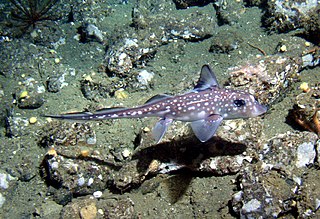
The spotted ratfish is a chimaera found in the north-eastern Pacific Ocean. Often seen by divers at night in the Pacific Northwest, this cartilaginous fish gets its characteristic name from a pointed rat-like tail. The ratfish lays leathery egg cases on the bottom of muddy or sandy areas, which are often mistaken by divers as something inanimate. While mainly a deep-water species, it occurs at shallower depths in the northern part of its range. The generic name, Hydrolagus, comes from the Greek words ὕδωρ, meaning water, and λαγώς/λαγῶς, meaning hare, and the specific name honors Alexander Collie, who was a ship surgeon and early naturalist. The spotted ratfish is common in much of its range, not typically eaten by humans, and is not commercially caught.
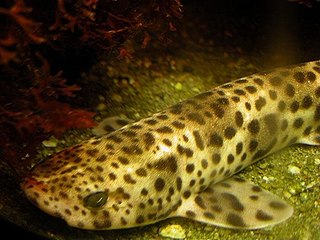
The nursehound, also known as the large-spotted dogfish, greater spotted dogfish or bull huss, is a species of catshark, belonging to the family Scyliorhinidae, found in the northeastern Atlantic Ocean. It is generally found among rocks or algae at a depth of 20–60 m (66–197 ft). Growing up to 1.6 m (5.2 ft) long, the nursehound has a robust body with a broad, rounded head and two dorsal fins placed far back. It shares its range with the more common and closely related small-spotted catshark, which it resembles in appearance but can be distinguished from, in having larger spots and nasal skin flaps that do not extend to the mouth.

Ostracion is a genus of the boxfish family Ostraciidae. Fish in the Genus are known as Box Puffer. It was first described by Carl Linnaeus in 1758.

The red Irish lord is a species of fish in the family Cottidae. It is found in the northern Pacific Ocean, from Russia to Alaska and as far south as Monterey Bay. It is a distinctly red fish, with brown, yellow, white, and black mottling, that is generally around 30 cm (12 in) long, though specimens can grow to up to 51 cm (20 in) in length. German naturalist Wilhelm Gottlieb Tilesius formally described it in 1811. Carnivorous, it hides camouflaged among rocks on the ocean floor and lashes out to seize its prey—crabs, fish and shrimp.

The thornback ray, or thornback skate, is a species of ray fish in the family Rajidae.
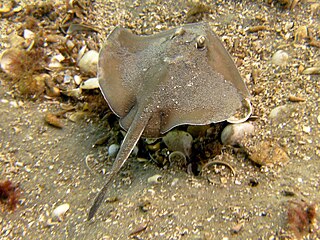
The sparsely-spotted stingaree, also known as the white-spotted stingaree or Dixon's stingaree, is a species of stingray in the family Urolophidae, common off the southern Australian coast. Preferring sandy flats and seagrass beds, this benthic ray can be found from close to shore to a depth of at least 150 m (490 ft), and tends to occur deeper in the northern portion of its range. Reaching a length of 57 cm (22 in), this species has a broad, diamond-shaped pectoral fin disc that is typically plain gray in color above with a V-shaped marking between the eyes. Individuals from southerly waters also generally exhibit a smattering of small, dark-edged white spots. This ray is further characterized by a distinctively bell-shaped curtain of skin between the nostrils. Its tail has a skin fold running along either side and a leaf-shaped caudal fin, but no dorsal fin.

The lined seahorse, northern seahorse or spotted seahorse, is a species of fish that belongs to the family Syngnathidae. H. erectus is a diurnal species with an approximate length of 15 cm and lifespan of one to four years. The H. erectus species can be found in myriad colors, from greys and blacks to reds, greens, and oranges. The lined seahorse lives in the western Atlantic Ocean as far north as Canada and as far south as the Caribbean, Mexico, and Venezuela. It swims in an erect position and uses its dorsal and pectoral fins for guidance while swimming.

The queen coris, also known as the sand wrasse, Queen coris wrasse, Formosan coris, Formosa coris wrasse, Formosa wrasse, Indian Ocean wrasse or Indian sand wrasse, is a species of wrasse native to the Indian Ocean from the Red Sea and the coast of east Africa to Sri Lanka. This species appears in the aquarium trade due to its vibrant colors. A special feature about this species is how much they change from juvenile to adult form, in color, behaviour, and diet.
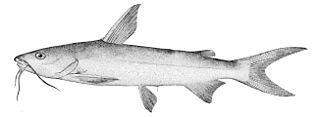
The hardhead catfish is a species of sea catfish from the northwest Atlantic and Gulf of Mexico, and similar to the gafftopsail catfish. It is one of four species in the genus Ariopsis. The common name, hardhead catfish, is derived from the presence of a hard, bony plate extending rearward toward the dorsal fin from a line between the catfish's eyes. It is an elongated marine catfish that reaches up to 28 in (70 cm) in length and 12 lb (5.5 kg) in weight. Their typical weight is less than 1 lb (450 g), but they commonly reach up to 3 lb (1.4 kg). They are often a dirty gray color on top, with white undersides.
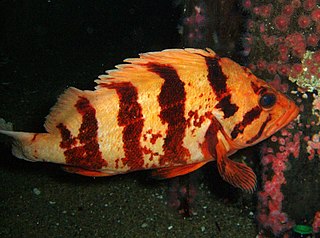
The tiger rockfish, also called tiger seaperch, banded rockfish and black-banded rockfish, is a species of marine ray-finned fish belonging to the subfamily Sebastinae, the rockfishes, part of the family Scorpaenidae. It is native to the waters of the Pacific Ocean off western North America.

Synodontis clarias, known as the red tailed synodontis, or the mandi, is a species of upside-down catfish that occurs widely in the waters of northern Africa. It was first described by Swedish zoologist Carl Linnaeus in 1758 as Silurus clarias. The original specimens were obtained in Egypt, near Cairo. The meaning of the species name clarias is not certain, but may possibly have been used to mean "bright" or "clear".

The quillback rockfish, also known as the quillback seaperch, is a species of marine ray-finned fish belonging to the subfamily Sebastinae, the rockfishes, part of the family Scorpaenidae. This species primarily dwells in salt water reefs. The average adult weighs 2–7 pounds and may reach 1 m in length. Quillback rockfish are named for the sharp, venomous quills or spines on the dorsal fin. Their mottled orange-brown coloring allows them to blend in with rocky bottom reefs. The quillback rockfish eats mainly crustaceans, but will also eat herring. They are solitary and minimally migratory, but not territorial, and give birth to live young (viviparous). They are a popular sport fish, generally caught in cold water 41–60 m deep, but also to subtidal depths of 275 m.
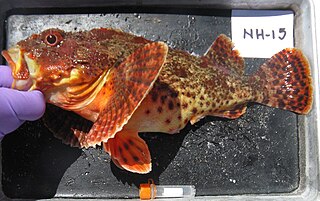
Scorpaena guttata is a species of fish in the scorpionfish family known by the common name California scorpionfish. It is native to the eastern Pacific Ocean, where it can be found along the coast of California and Baja California. Its distribution extends from around Santa Cruz, California, to Punta Abreojos in Baja California Sur, and out to Guadalupe Island. It is also found in the Gulf of California. Another common name is spotted scorpionfish.

Aracana aurita, striped cowfish, Shaw's cowfish, striped boxfish, painted boxfish, southern cowfish or Shaw's boxfish is a species of boxfish native to the Eastern Indian Ocean. The species was first described by George Shaw in 1798. It is carnivorous and exposes prey in the benthic zone by blowing a jet of water onto sediment.

The eyed flounder is a species of fish in the family Bothidae. The species is found on or near the sandy seabed in relatively shallow waters in the western Atlantic Ocean, the Caribbean Sea and the Gulf of Mexico.
